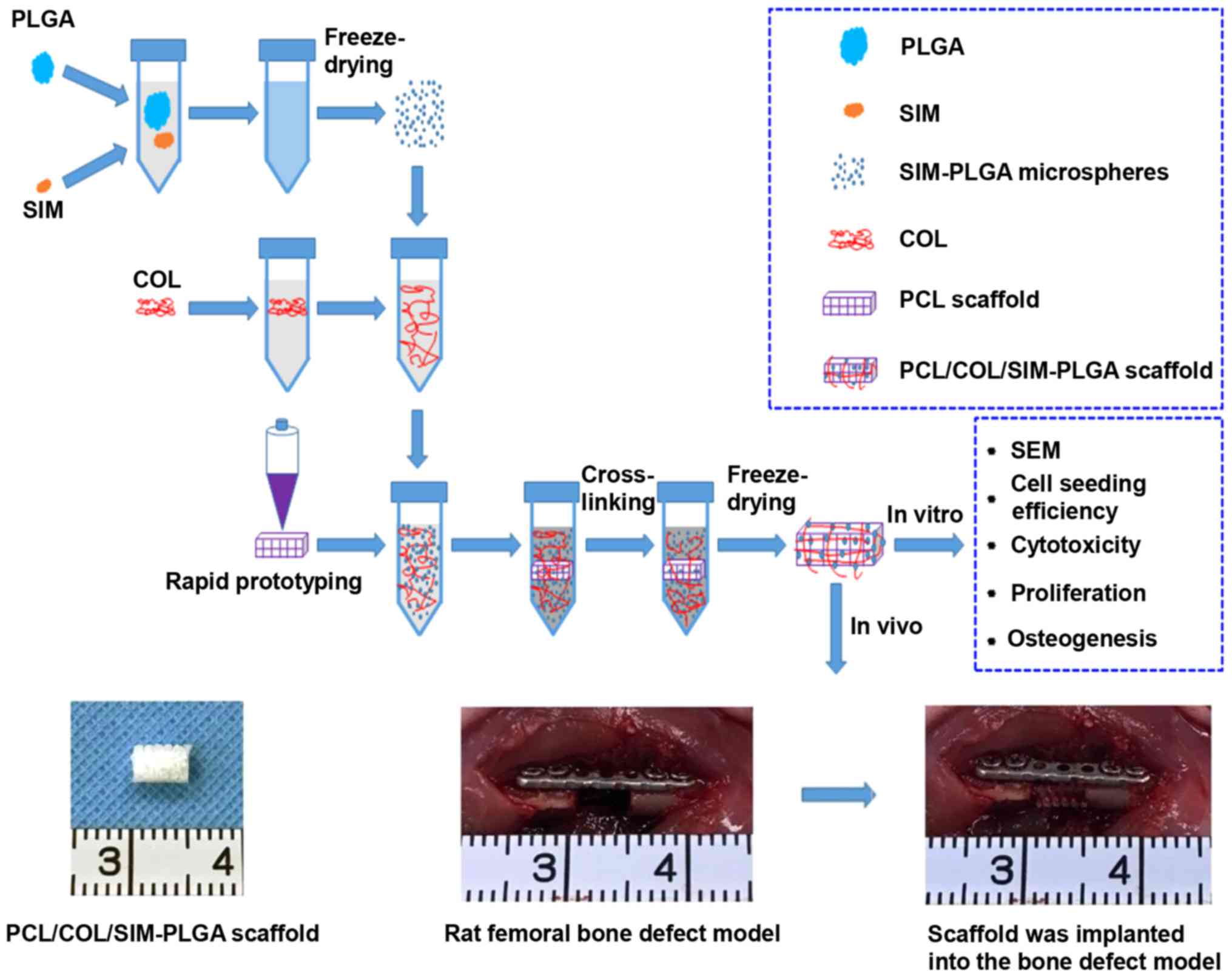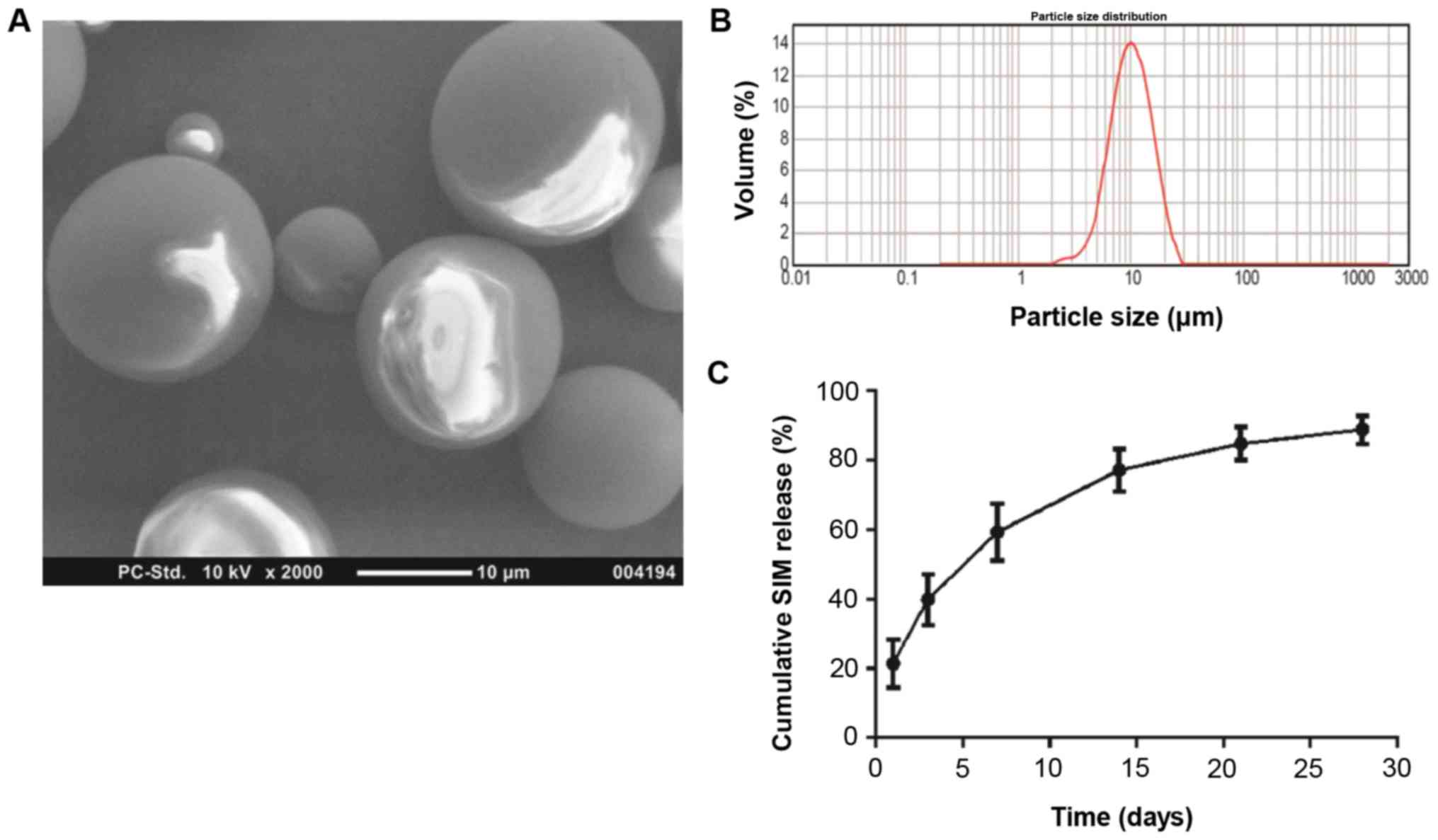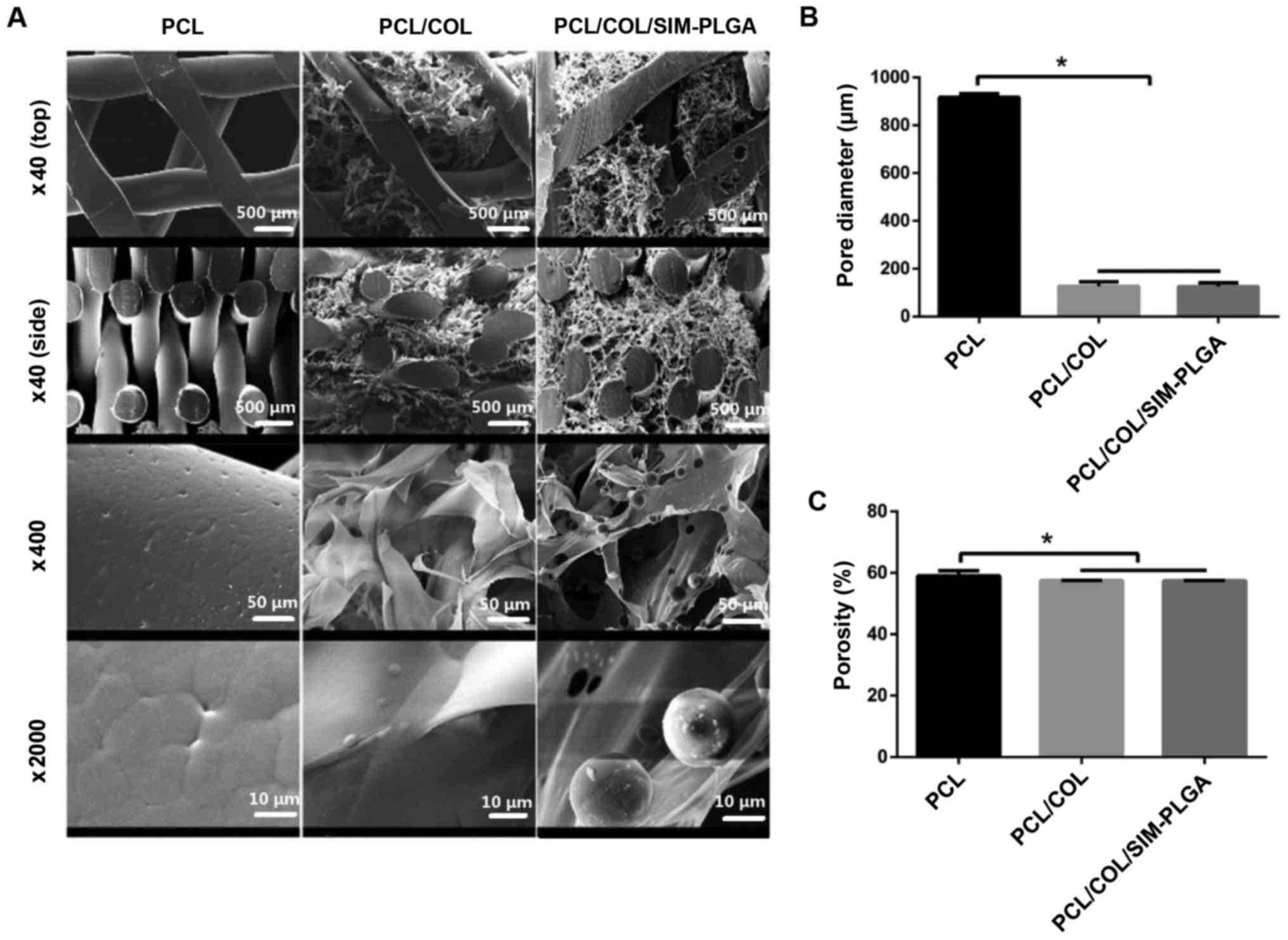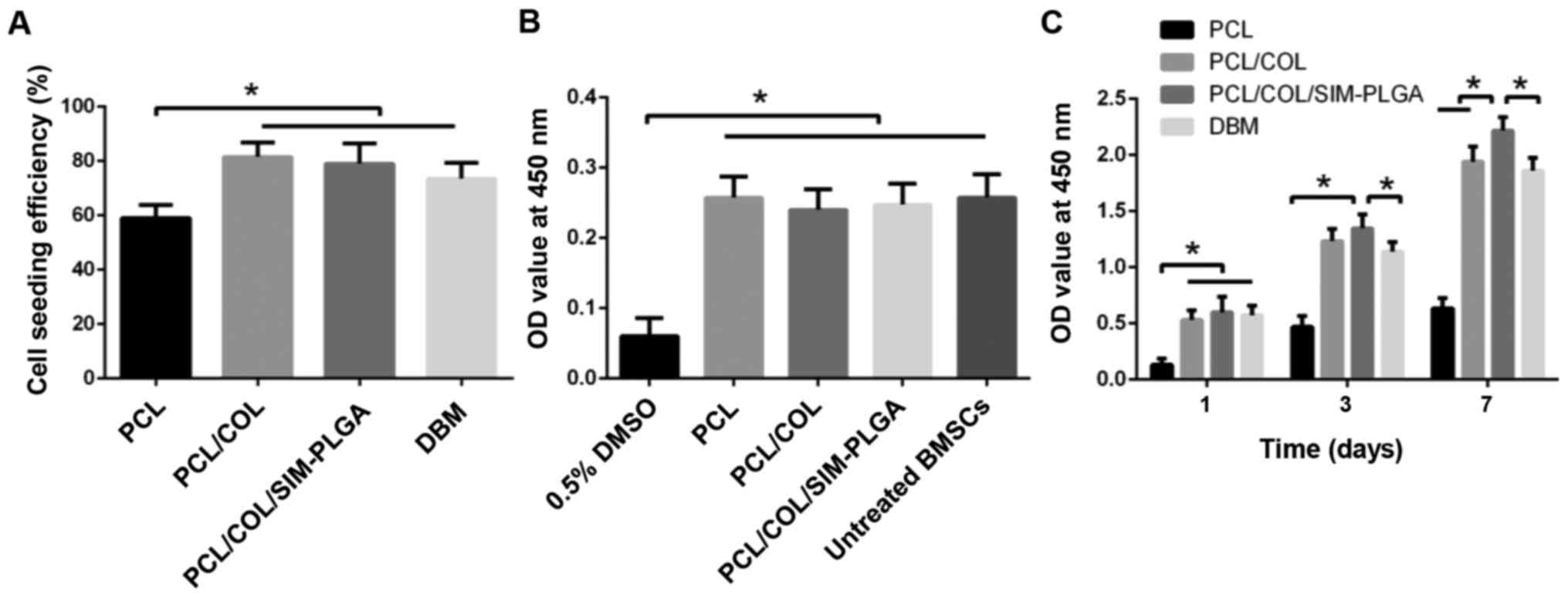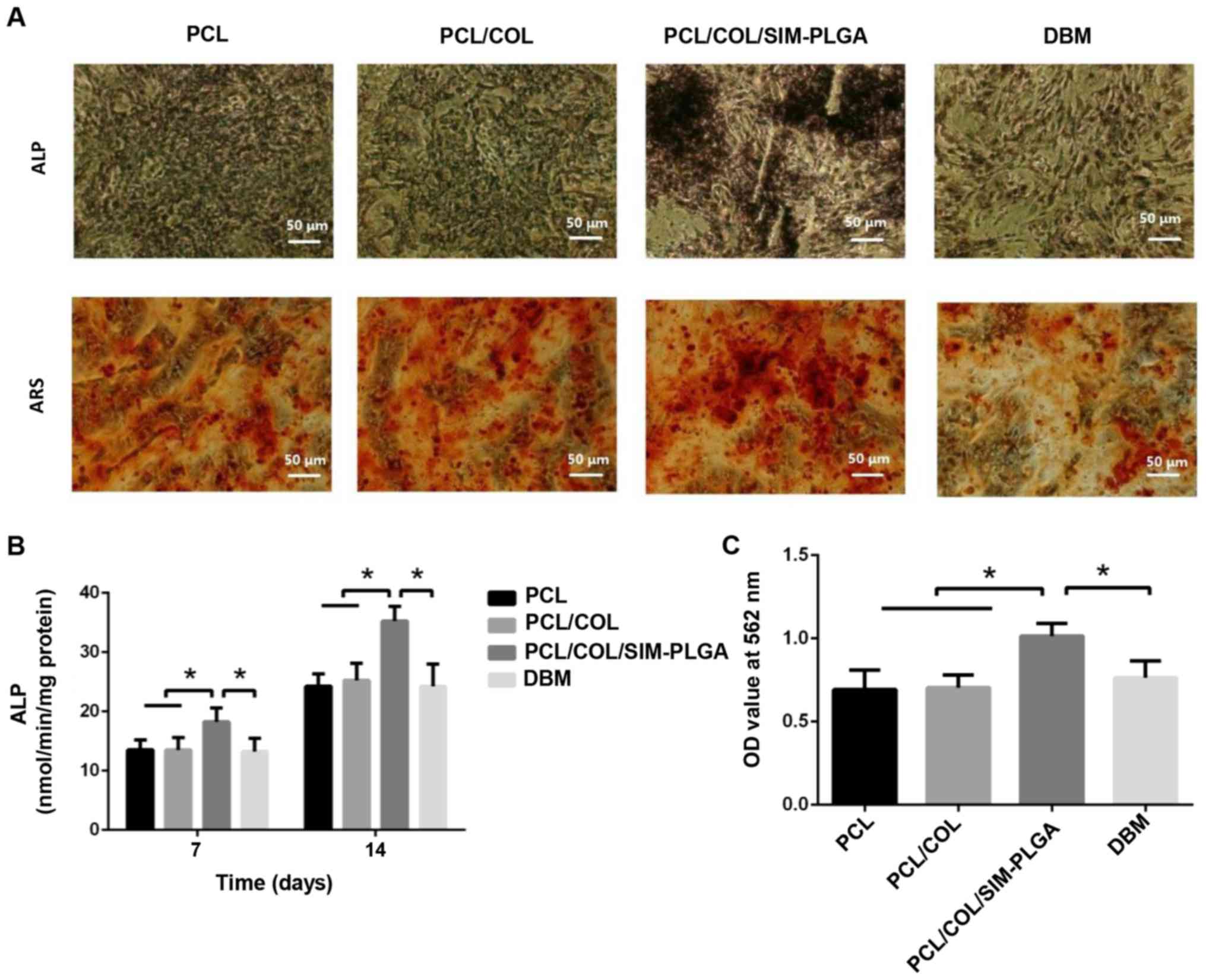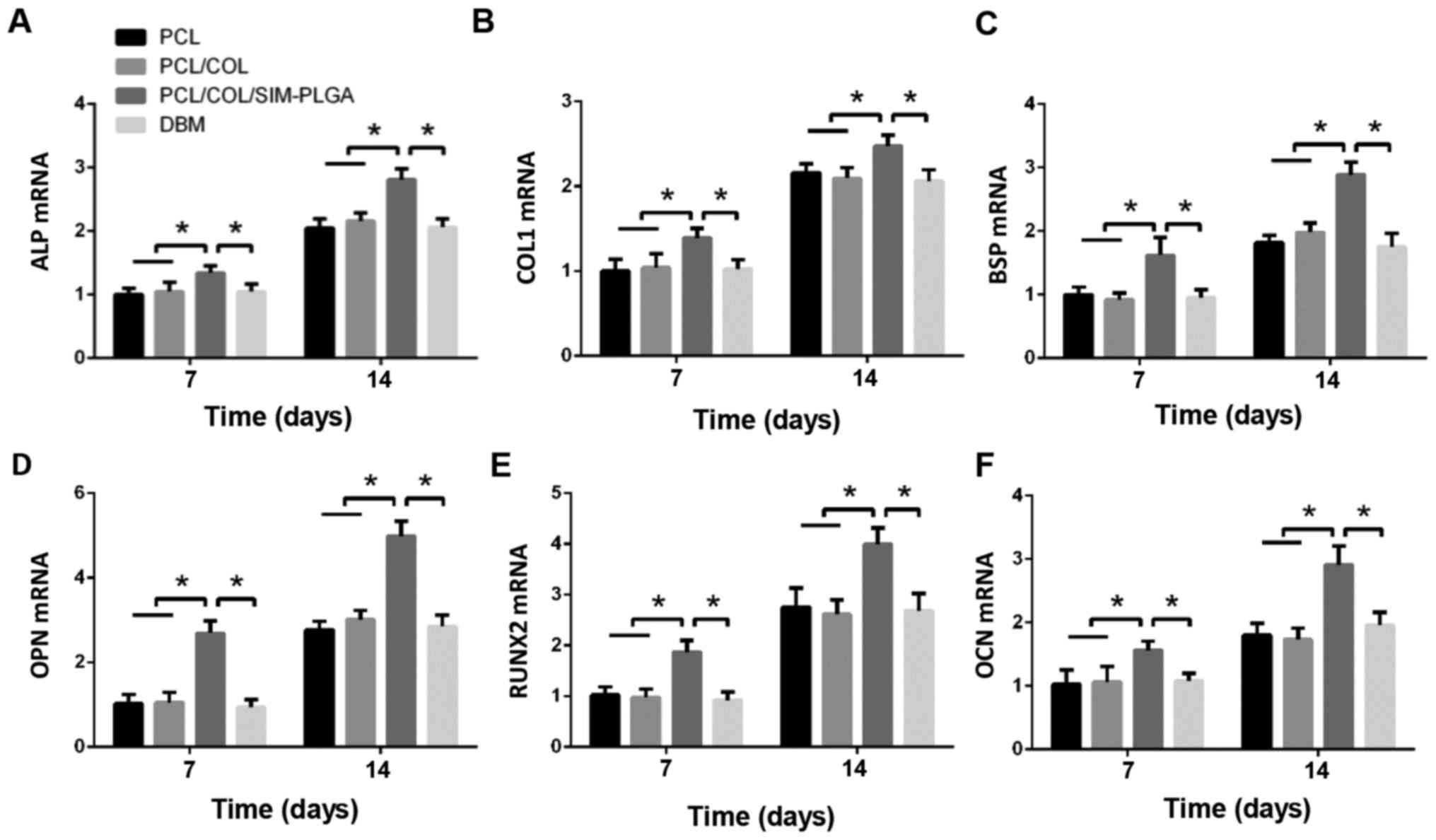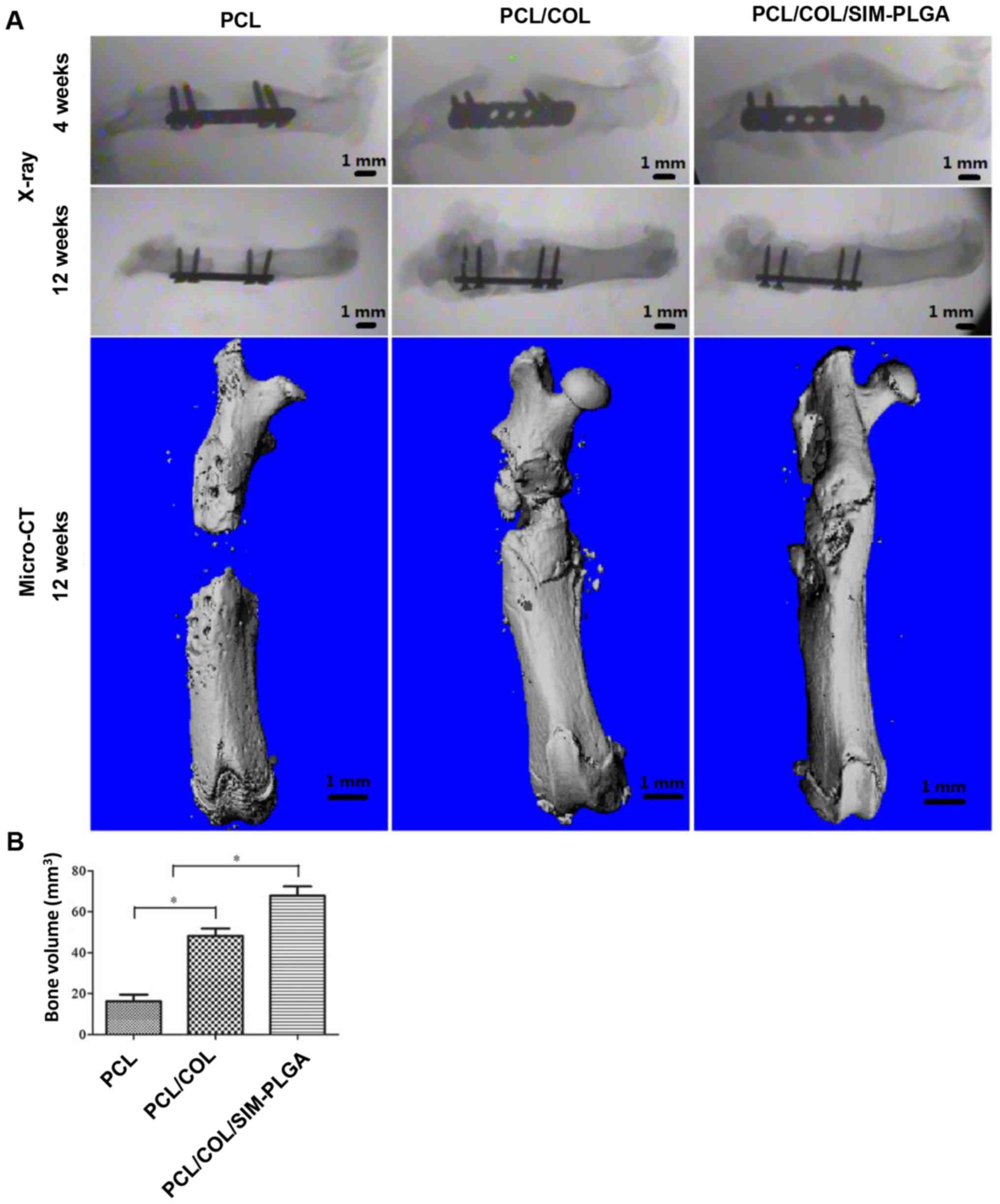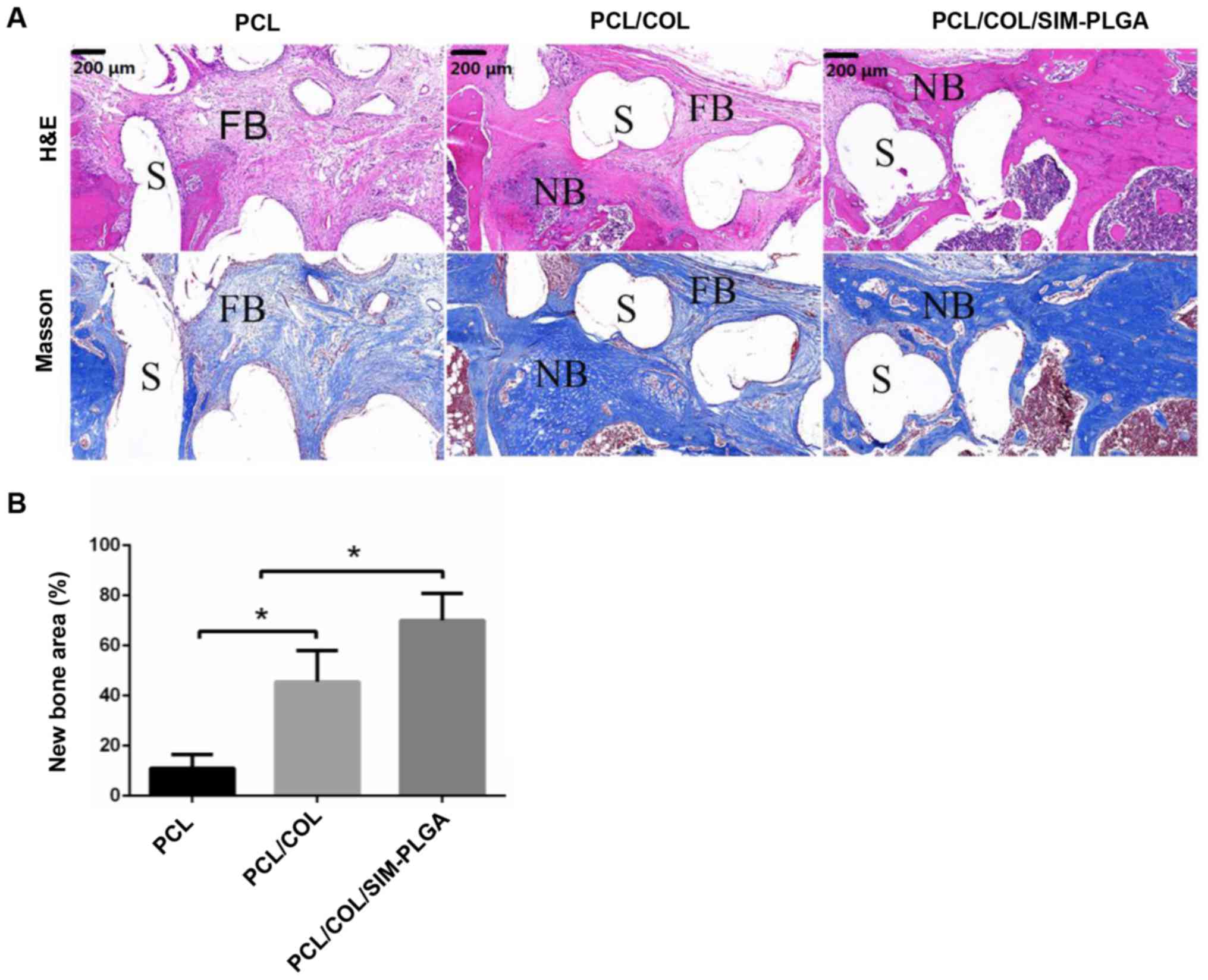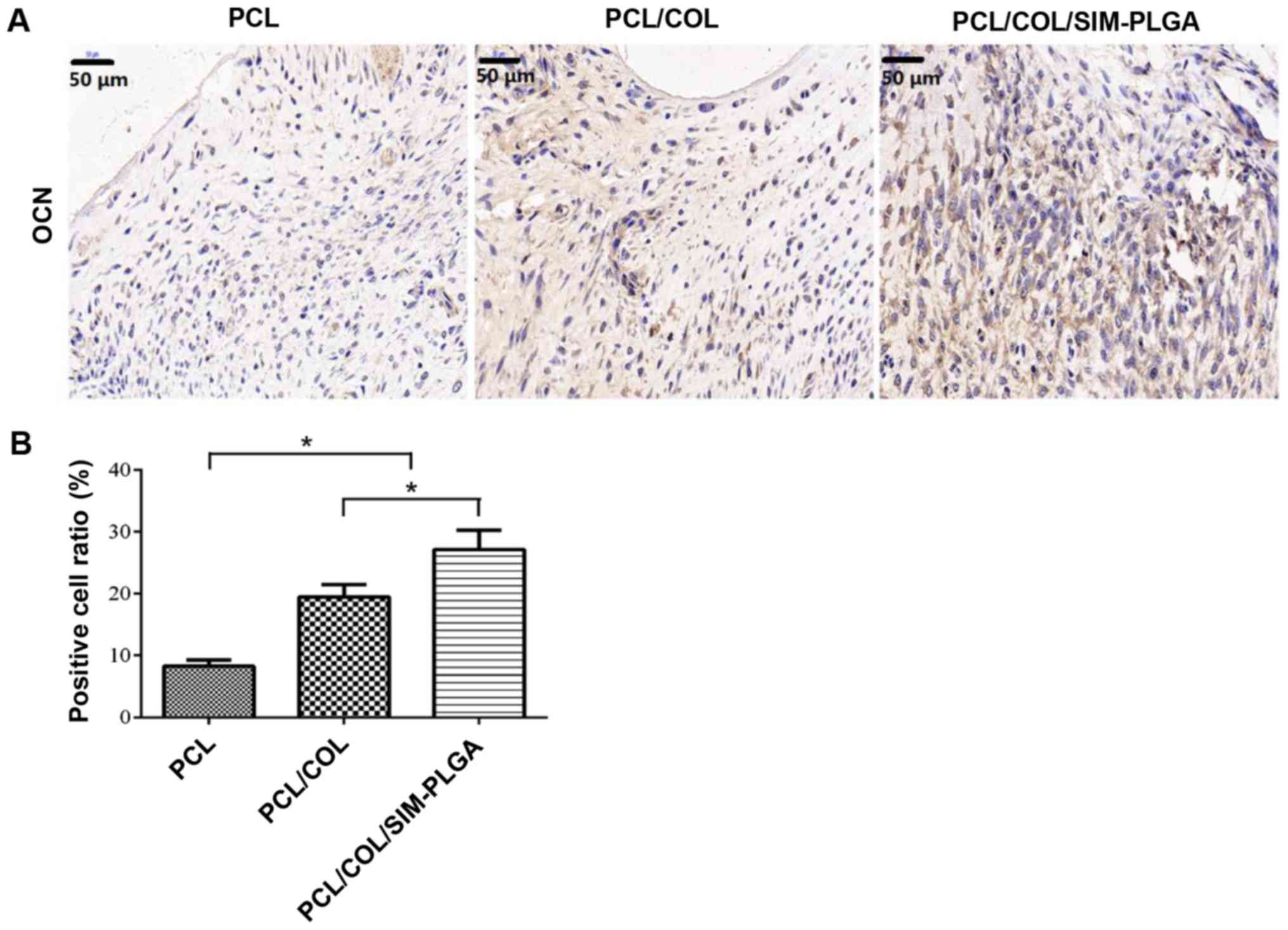|
1
|
Weisgerber DW, Erning K, Flanagan CL,
Hollister SJ and Harley BAC: Evaluation of multi-scale mineralized
collagen-polycaprolactone composites for bone tissue engineering. J
Mech Behav Biomed Mater. 61:318–327. 2016. View Article : Google Scholar : PubMed/NCBI
|
|
2
|
Kasuya A, Sobajima S and Kinoshita M: In
vivo degradation and new bone formation of calcium phosphate
cement-gelatin powder composite related to macroporosity after in
situ gelatin degradation. J Orthop Res. 30:1103–1111. 2012.
View Article : Google Scholar : PubMed/NCBI
|
|
3
|
Zhang J, Wang L, Zhang W, Zhang M and Luo
ZP: Synchronization of calcium sulphate cement degradation and new
bone formation is improved by external mechanical regulation. J
Orthop Res. 33:685–691. 2015. View Article : Google Scholar : PubMed/NCBI
|
|
4
|
Li L, Zuo Y, Zou Q, Yang B, Lin L, Li J
and Li Y: Hierarchical structure and mechanical improvement of an
n-HA/GCO-PU composite scaffold for bone regeneration. ACS Appl
Mater Interfaces. 7:22618–22629. 2015. View Article : Google Scholar : PubMed/NCBI
|
|
5
|
Wang J, Wu D, Zhang Z, Li J, Shen Y, Wang
Z, Li Y, Zhang ZY and Sun J: Biomimetically ornamented rapid
prototyping fabrication of an apatite-collagen-polycaprolactone
composite construct with nano-micro-macro hierarchical structure
for large bone defect treatment. ACS Appl Mater Interfaces.
7:26244–26256. 2015. View Article : Google Scholar : PubMed/NCBI
|
|
6
|
Pilia M, Guda T and Appleford M:
Development of composite scaffolds for load-bearing segmental bone
defects. Biomed Res Int. 2013:4582532013. View Article : Google Scholar : PubMed/NCBI
|
|
7
|
Inzana JA, Olvera D, Fuller SM, Kelly JP,
Graeve OA, Schwarz EM, Kates SL and Awad HA: 3D printing of
composite calcium phosphate and collagen scaffolds for bone
regeneration. Biomaterials. 35:4026–4034. 2014. View Article : Google Scholar : PubMed/NCBI
|
|
8
|
Papadimitropoulos A, Riboldi SA,
Tonnarelli B, Piccinini E, Woodruff MA, Hutmacher DW and Martin I:
A collagen network phase improves cell seeding of open-pore
structure scaffolds under perfusion. J Tissue Eng Regen Med.
7:183–191. 2013. View
Article : Google Scholar : PubMed/NCBI
|
|
9
|
Zein I, Hutmacher DW, Tan KC and Teoh SH:
Fused deposition modeling of novel scaffold architectures for
tissue engineering applications. Biomaterials. 23:1169–1185. 2002.
View Article : Google Scholar : PubMed/NCBI
|
|
10
|
Siddiqui N, Asawa S, Birru B, Baadhe R and
Rao S: PCL-based composite scaffold matrices for tissue engineering
applications. Mol Biotechnol. 2018. View Article : Google Scholar : PubMed/NCBI
|
|
11
|
Kim W, Jang CH and Kim G: Optimally
designed collagen/polycaprolactone biocomposites supplemented with
controlled release of HA/TCP/rhBMP-2 and HA/TCP/PRP for hard tissue
regeneration. Mater Sci Eng C Mater Biol Appl. 78:763–772. 2017.
View Article : Google Scholar : PubMed/NCBI
|
|
12
|
Cui Z, Lin L, Si J, Luo Y, Wang Q, Lin Y,
Wang X and Chen W: Fabrication and characterization of chitosan/OGP
coated porous poly(epsilon-caprolactone) scaffold for bone tissue
engineering. J Biomater Sci Polym Ed. 28:826–845. 2017. View Article : Google Scholar : PubMed/NCBI
|
|
13
|
Kiran S, Nune KC and Misra RD: The
significance of grafting collagen on polycaprolactone composite
scaffolds: Processing-structure-functional property relationship. J
Biomed Mater Res A. 103:2919–2931. 2015. View Article : Google Scholar : PubMed/NCBI
|
|
14
|
Pek YS, Gao S, Arshad MS, Leck KJ and Ying
JY: Porous collagen-apatite nanocomposite foams as bone
regeneration scaffolds. Biomaterials. 29:4300–4305. 2008.
View Article : Google Scholar : PubMed/NCBI
|
|
15
|
Xie C, Lu X, Han L, Xu J, Wang Z, Jiang L,
Wang K, Zhang H, Ren F and Tang Y: Biomimetic mineralized
hierarchical graphene oxide/chitosan scaffolds with adsorbability
for immobilization of nanoparticles for biomedical applications.
ACS Appl Mater Interfaces. 8:1707–1717. 2016. View Article : Google Scholar : PubMed/NCBI
|
|
16
|
Wang C, Zhao Q and Wang M: Cryogenic 3D
printing for producing hierarchical porous and rhBMP-2-loaded
Ca-P/PLLA nanocomposite scaffolds for bone tissue engineering.
Biofabrication. 9:0250312017. View Article : Google Scholar : PubMed/NCBI
|
|
17
|
Yan Q, Xiao LQ, Tan L, Sun W, Wu T, Chen
LW, Mei Y and Shi B: Controlled release of simvastatin-loaded
thermo-sensitive PLGA-PEG-PLGA hydrogel for bone tissue
regeneration: In vitro and in vivo characteristics. J Biomed Mater
Res A. 103:3580–3589. 2015. View Article : Google Scholar : PubMed/NCBI
|
|
18
|
Papadimitriou K, Karkavelas G, Vouros I,
Kessopoulou E and Konstantinidis A: Effects of local application of
simvastatin on bone regeneration in femoral bone defects in rabbit.
J Craniomaxillofac Surgy. 43:232–237. 2015. View Article : Google Scholar
|
|
19
|
Montero J, Manzano G and Albaladejo A: The
role of topical simvastatin on bone regeneration: A systematic
review. J Clin Exp Dent. 6:e286–e290. 2014. View Article : Google Scholar : PubMed/NCBI
|
|
20
|
Tanigo T, Takaoka R and Tabata Y:
Sustained release of water-insoluble simvastatin from biodegradable
hydrogel augments bone regeneration. J Control Release.
143:201–206. 2010. View Article : Google Scholar : PubMed/NCBI
|
|
21
|
Park JB: The use of simvastatin in bone
regeneration. Med Oral Patol Oral Cir Bucal. 14:e485–e488.
2009.PubMed/NCBI
|
|
22
|
Mir M, Ahmed N and Rehman AU: Recent
applications of PLGA based nanostructures in drug delivery.
Colloids Surf B Biointerfaces. 159:217–231. 2017. View Article : Google Scholar : PubMed/NCBI
|
|
23
|
Li H, Liao H, Bao C, Xiao Y and Wang Q:
Preparation and evaluations of mangiferin-loaded PLGA scaffolds for
alveolar bone repair treatment under the diabetic condition. AAPS
Pharm Sci Tech. 18:529–538. 2017. View Article : Google Scholar
|
|
24
|
Hu X, Zhang J, Tang X, Li M, Ma S, Liu C,
Gao Y, Zhang Y, Liu Y, Yu F, et al: An accelerated release method
of risperidone loaded PLGA microspheres with good IVIVC. Curr Drug
Deliv. 15:87–96. 2018. View Article : Google Scholar : PubMed/NCBI
|
|
25
|
Huang J, Chen Z, Li Y, Li L and Zhang G:
Rifapentine-linezolid-loaded PLGA microspheres for interventional
therapy of cavitary pulmonary tuberculosis: Preparation and in
vitro characterization. Drug Des Devel Ther. 11:585–592. 2017.
View Article : Google Scholar : PubMed/NCBI
|
|
26
|
Li Y and Zhang Z and Zhang Z: Porous
chitosan/nano-hydroxyapatite composite scaffolds incorporating
simvastatin-loaded PLGA microspheres for bone repair. Cells Tissues
Organs. 205:20–31. 2018. View Article : Google Scholar : PubMed/NCBI
|
|
27
|
Fernández-Sánchez L, Bravo-Osuna I, Lax P,
Arranz-Romera A, Maneu V, Esteban-Pérez S, Pinilla I,
Puebla-González MDM, Herrero-Vanrell R and Cuenca N: Controlled
delivery of tauroursodeoxycholic acid from biodegradable
microspheres slows retinal degeneration and vision loss in P23H
rats. PLoS One. 12:e01779982017. View Article : Google Scholar : PubMed/NCBI
|
|
28
|
Jeong C, Kim SE, Shim KS, Kim HJ, Song MH,
Park K and Song HR: Exploring the in vivo anti-inflammatory actions
of simvastatin-loaded porous microspheres on inflamed tenocytes in
a collagenase-induced animal model of achilles tendinitis. Int J
Mol Sci. 19:E8202018. View Article : Google Scholar : PubMed/NCBI
|
|
29
|
Qiao F, Zhang J, Wang J, Du B, Huang X,
Pang L and Zhou Z: Silk fibroin-coated PLGA dimpled microspheres
for retarded release of simvastatin. Colloids Surf B Biointerfaces.
158:112–118. 2017. View Article : Google Scholar : PubMed/NCBI
|
|
30
|
Yu WL, Sun TW, Qi C, Zhao HK, Ding ZY,
Zhang ZW, Sun BB, Shen J, Chen F, Zhu YJ, et al: Enhanced
osteogenesis and angiogenesis by mesoporous hydroxyapatite
microspheres-derived simvastatin sustained release system for
superior bone regeneration. Sci Rep. 7:441292017. View Article : Google Scholar : PubMed/NCBI
|
|
31
|
Li Y and Zhang ZZ: Sustained curcumin
release from PLGA microspheres improves bone formation under
diabetic conditions by inhibiting the reactive oxygen species
production. Drug Des Devel Ther. 12:1453–1466. 2018. View Article : Google Scholar : PubMed/NCBI
|
|
32
|
Zhang W, Chang Q, Xu L, Li G, Yang G, Ding
X, Wang X, Cui D and Jiang X: Graphene oxide-copper
nanocomposite-coated porous CaP scaffold for vascularized bone
regeneration via activation of Hif-1α. Adv Healthc Mater.
5:1299–1309. 2016. View Article : Google Scholar : PubMed/NCBI
|
|
33
|
Xie H, Wang Z, Zhang L, Lei Q, Zhao A,
Wang H, Li Q, Cao Y, Zhang Jie W and Chen Z: Extracellular
vesicle-functionalized decalcified bone matrix scaffolds with
enhanced pro-angiogenic and pro-bone regeneration activities. Sci
Rep. 7:456222017. View Article : Google Scholar : PubMed/NCBI
|
|
34
|
Shen X, Zhang Y, Gu Y, Xu Y, Liu Y, Li B
and Chen L: Sequential and sustained release of SDF-1 and BMP-2
from silk fibroin-nanohydroxyapatite scaffold for the enhancement
of bone regeneration. Biomaterials. 106:205–216. 2016. View Article : Google Scholar : PubMed/NCBI
|
|
35
|
Li Y, Gao X and Wang J: Human
adipose-derived mesenchymal stem cell-conditioned media suppresses
inflammatory bone loss in a lipopolysaccharide-induced murine
model. Exp Ther Med. 15:1839–1846. 2018.PubMed/NCBI
|
|
36
|
Livak KJ and Schmittgen TD: Analysis of
relative gene expression data using real-time quantitative PCR and
the 2(-Delta Delta C(T)) method. Methods. 25:402–408. 2001.
View Article : Google Scholar : PubMed/NCBI
|
|
37
|
National Research Council Committee for
the Update of the Guide for the Care and Use of Laboratory Animals:
The National Academies Collection: Reports funded by National
Institutes of Health, . In: Guide for the Care and Use of
Laboratory Animals. th (ed). National Academies Press (US) National
Academy of Sciences; Washington (DC): 2011
|
|
38
|
Sun X, Wang J, Wang Y and Zhang Q:
Collagen-based porous scaffolds containing PLGA microspheres for
controlled kartogenin release in cartilage tissue engineering.
Artif Cells Nanomed Biotechnol. 1–10. 2017. View Article : Google Scholar
|
|
39
|
Fahimipour F, Rasoulianboroujeni M,
Dashtimoghadam E, Khoshroo K, Tahriri M, Bastami F, Lobner D and
Tayebi L: 3D printed TCP-based scaffold incorporating VEGF-loaded
PLGA microspheres for craniofacial tissue engineering. Dent Mater.
33:1205–1216. 2017. View Article : Google Scholar : PubMed/NCBI
|
|
40
|
Ramazani F, Chen W, van Nostrum CF, Storm
G, Kiessling F, Lammers T, Hennink WE and Kok RJ: Strategies for
encapsulation of small hydrophilic and amphiphilic drugs in PLGA
microspheres: State-of-the-art and challenges. Int J Pharm.
499:358–367. 2016. View Article : Google Scholar : PubMed/NCBI
|
|
41
|
Giteau A, Venier-Julienne MC,
Aubert-Pouëssel A and Benoit JP: How to achieve sustained and
complete protein release from PLGA-based microparticles? Int J
Pharm. 350:14–26. 2008. View Article : Google Scholar : PubMed/NCBI
|
|
42
|
Oryan A, Kamali A and Moshiri A: Potential
mechanisms and applications of statins on osteogenesis: Current
modalities, conflicts and future directions. J Control Release.
215:12–24. 2015. View Article : Google Scholar : PubMed/NCBI
|
|
43
|
Du L, Yang S, Li W, Li H, Feng S, Zeng R,
Yu B, Xiao L, Nie HY and Tu M: Scaffold composed of porous
vancomycin-loaded poly(lactide-co-glycolide) microspheres: A
controlled-release drug delivery system with shape-memory effect.
Mater Sci Eng C Mater Biol Appl. 78:1172–1178. 2017. View Article : Google Scholar : PubMed/NCBI
|
|
44
|
Guelcher SA, Brown KV, Li B, Guda T, Lee
BH and Wenke JC: Dual-purpose bone grafts improve healing and
reduce infection. J Orthop Trauma. 25:477–482. 2011. View Article : Google Scholar : PubMed/NCBI
|
|
45
|
Liu H, Yang L, Zhang E, Zhang R, Cai D,
Zhu S, Ran J, Bunpetch V, Cai Y, Heng BC, et al: Biomimetic tendon
extracellular matrix composite gradient scaffold enhances
ligament-to-bone junction reconstruction. Acta Biomater.
56:129–140. 2017. View Article : Google Scholar : PubMed/NCBI
|
|
46
|
Du Y, Liu H, Yang Q, Wang S, Wang J, Ma J,
Noh I, Mikos AG and Zhang S: Selective laser sintering scaffold
with hierarchical architecture and gradient composition for
osteochondral repair in rabbits. Biomaterials. 137:37–48. 2017.
View Article : Google Scholar : PubMed/NCBI
|
|
47
|
Amini AR, Wallace JS and Nukavarapu SP:
Short-term and long-term effects of orthopedic biodegradable
implants. J Long Term Eff Med Implants. 21:93–122. 2011. View Article : Google Scholar : PubMed/NCBI
|
|
48
|
Nezu T and Winnik FM: Interaction of
water-soluble collagen with poly(acrylic acid). Biomaterials.
21:415–419. 2000. View Article : Google Scholar : PubMed/NCBI
|
|
49
|
Hollister SJ: Porous scaffold design for
tissue engineering. Nat Mater. 4:518–524. 2005. View Article : Google Scholar : PubMed/NCBI
|















